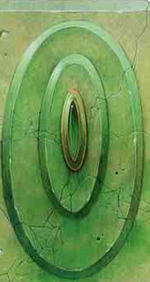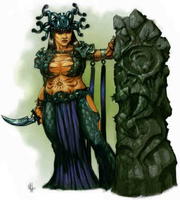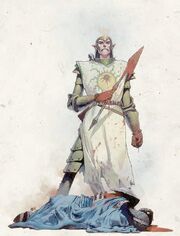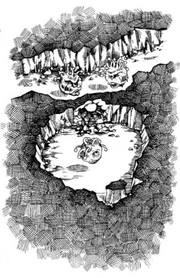The Great Mother, sometimes specified as the Great Beholder Mother,[7] was the eldritch matron deity of the beholders. Her title simply referred to her role as their progenitor rather than as an indicator of her questionable gender. Beholders themselves lacked a name for her and felt no need to give her one.[9]
Description[]

The Great Mother's symbol, an egg with a central eye
The Great Mother's avatar appeared as a gargantuan beholder, 18 ft (5.5 m) in diameter, that slowly and silently drifted through the air.[6] Her bloated body was coated in a layer of random debris, including small stones and shells, encrusted gems, armor scraps, damaged weapons, skeletons, dragon's teeth and other refuse.[6][8] It was thought that the features of the Great Mother's form were in a state of constant flux as a result of her utter complexity. Despite her ever-changing form, her presence was always enchanting to beholders since their own distorted minds remembered her as having their traits.[8]
Personality[]
Those that studied the Great Mother typically concluded that she was completely insane, lacking in the ruthless logic possessed by mortal beholders. In truth, she was not only intelligent but dangerously so, the method behind her madness simply being beyond the ability of most beings to understand.[5] Ironically, her mind wasn't even divided into two halves, like most beholders. Still, while not crazy or mindless, the Great Mother was a creature of utter chaos, capricious whimsy, and incoherent thought patterns, acting primarily on instinct and impulse.[6][8]
Often times, the Great Mother philosophized to herself about the nature of chaos and evil and was rumored to be the greatest sage on the subjects.[6] She was said to be omniscient according to beholders and did, in truth, possess exclusive hidden lore, but seemed to be so knowledgeable that she was incapable of sharing it with any but the most intelligent entities, much less inferior beings.[5]
Some scholars speculated that the Great Mother was not unable to convey her knowledge, but simply wouldn't provide it to lower-lifeforms.[8] Indeed, the Great Mother was a jealous and egotistical intellectual that refused to acknowledge even the notion that she could be mistaken. Befitting the deity of eye tyrants, she was a dictatorial deity said to have her own strange standards for her creations, and would destroy or devour any that she found displeasing.[6]
Powers[]
The Great Mother's avatar had eye rays that were equivalent to those found on normal beholders, although some were stronger and farther reaching. Her sheer mass took the brunt of most attacks, with only magical armaments being able to harm her and bludgeoning weapons being only half as effective. She could radiate an aura of fear, chill, repulsion or hopelessness. Those eaten by the Great Mother would quickly be dissolved in her stomach acid, although they could still attempt to fight her from the inside.[6][8]
Possessions[]
The Great Mother possessed a cache of magical treasures and lore somewhere in the Outlands.[6]
Realm[]
The Great Mother dwelt in the 6th layer of the Abyss known as the Realm of a Million Eyes, a cave system of innumerable twisting tunnels,[10] many of which were vertical. The walls of the realm were studded with eyes, each an eye of the Great Mother herself, indicating how gigantic she truly was.[10]
Evil beholders and beholderkin of every type were abundant within the realm, especially those of great devotion, and preyed upon each another along with anyone else, demon or otherwise, that stumbled into it.[3][11] The most cruel and elderly beholder petitioners acted as the enforcers of the realm since the Great Mother herself had no interest in managing her domain.[3]
Only the Great Mother herself knew of the location of her true lair,[6] a massive cavern sub-plane hidden deep underneath the sinkholes and shafts. Within her chamber she would spawn more beholders, eating anything that came near or progeny that stayed too long.[3]
Activities[]
Aside from birthing more beholders, the Great Mother's only other activity was drifting enigmatically in solitude throughout reality, particularly in the darker planes. She inexorably cruised through space deep in thought, always incomprehensibly gibbering in an alien protolanguage while experiencing bizarre visions.[6][8] The purpose of her aimless journey wasn't to gather knowledge or magical secrets, since unlike deities such as Ilsensine, she believed that she already knew all that was worth knowing.[6]
The Great Mother's true motivation was fairly simple; the primal drive to propagate and fill the multiverse with her spawn. She sought to replace all life with her children, and in that sense, each beholder was a reflection of her desire to self-replicate and remake reality in her image.[5][12] Her endless travels only came to temporary stops when she decided to produce offspring, either on other worlds or in her lair.[8] Neglectful and self-absorbed, she concerned herself only with the spread of her offspring, caring little for the irrelevant activities of mortals and gods alike.[6]
Even the activities of her own creations were considered trifling matters for she did not communicate to them through omens and only occasionally interceded when a great number were endangered, and many times not even then. Drow threats or lawful good interlopers were likely to draw her attention, but she just as well might allow the beholders of an entire world to go extinct.[6] Still, being a creature of unfathomable randomness, she might also manifest powers in response to invocations, send whole avatars to deal with issues regarding small groups or even more rarely attempt to avenge the death of just one.[6][8] It was thought that of the few things that could get the wandering Mother's attention, great interplanar magic such as permanent gates to other worlds could pique her interest enough for her to send avatars.[6]
Relationships[]
Though the precise nature of their relationship was questionable, whether he was her direct son or grandson, the lesser deity Gzemnid was the only one of her mortal descendants that had risen ascended to godhood.[6][8] Gzemnid dwelt underneath the Outlands purportedly because he was hiding from some major threat, said to be the Great Mother herself, and legends did say that he only escaped her wrath long ago due to his illusory skill.[7][6] Such claims appeared to be false because The Great Mother recognized and made noises of approval when she came across him and Gzemnid treated her with respect, albeit the form of respect given to a force of nature rather than a rational being.[8]
The Great Mother (presumably) seemed to have come to some kind of arrangement with Mystryl or the first Mystra to allow humans to draft or modify the goals of Vellurith. As for why and how this agreement came to be (perhaps as some form of peace treaty) it was unknown to even the likes of Elminster, who had personally altered some of the rules, and who speculated that his memories of the reason had been removed. The Great Mother either supported or approved of this even as at least some of the rules were designed to undermine or occupy the beholder race with long-term of disastrous ideas, while beholders suspected nothing of the sort.[13]
The Great Mother could count Kiaransalee of the Dark Seldarine among her few allies, though the other members (namely Lolth, Vhaeraun, Eilistraee, Selvetarm, and Ghaunadaur) were her foes, as were the duergar gods Laduguer and Deep Duerra, Callarduran Smoothhands of the deep gnomes, and the elven god of vengeance Shevarash, a general enemy of evil Underdark gods. [14]
Worshipers[]
Beholder clerics were incredibly rare, not simply because their antimagic eye normally neutralized any attempts to utilize divine magic, but because their minds normally lacked both the will and ability to conceive of being dedicated to higher powers.[5] As such, the Great Mother lacked an official priesthood to conduct rituals and celebrations or lead the devoted, nor did the Great Mother grant spells to her spawn, given the plethora of magical powers they already inherited.[6][8][15] What beholder priests did exist received powers only for use in times of conflict, whether between each other or with other threats,[15] and few involved material components due to their lacking ability to manipulate them.[16]
Despite such obstacles, beholders were greatly faithful creatures that expressed perpetual piety to the Great Mother in their own way. In the minds of beholders, the Great Mother was the perfect being and the personification of truth, with all other things being imperfect. In addition, all beholders viewed themselves as the closest that any physical being could come to mirroring true divinity, strongly believing from birth that they were the ultimate mortal incarnation of the Great Mother and vividly remembering the event as if she personally spawned them.[5]
It was for this reason that each beholder viewed the idea of belonging to a "beholder race" a ridiculous notion, held by lesser races unaware that they were truly unique beings.[5] Despite other true breeds of beholder being possible in their minds, beholders that were physically and mentally identical to themselves, they would dismiss such beings as "correct" versions and not divinity made flesh as they were.[15][17] Every beholder strived to truly exemplify the Great Mother in body and mind, and slaughtering inferior beholders, those that showed any variations, was the greatest possible display of devotion.[5]
Despite their reverence, beholders generally didn't wish for the Great Mother to be personally interested in them, instead holding her in a kind of fearful, religious awe.[6] Although their minds could misremember differences in physical form between themselves and the Great Mother, learning that the Great Mother's mind was so utterly alien even to them would, and likely already had to some, come as a massive shock. The clash between their preconceived notions of identity and the truth behind their idealized role model would, in all likelihood, slowly sever their already tenuous sanity.[8]
Variants[]
Normal beholders were not the only worshipers of the Great Mother, for she also received reverence from beholder-kin.[8] Elder orbs, beholders whose bodies never deteriorated with age, believed their immortality to be a sign that they embodied the Great Mother's eternal, elemental nature.[9] They aided the Great Mother by spreading her offspring across the planes, typically on worlds where they were few in number.[8]
Hive mothers were the direct descendants of the Great Mother and they themselves had the ability to spawn beholder abominations, specialized and sterile beholder-like monsters, an ability they regarded as a gift from the Great Mother.[8] Viewing themselves as her chosen, hive mothers used their ability to dominate other beholders in order to gather beholders and beholderkin together, believing it to be their duty to unite the scattered and quarrelsome members of the race. However, hive mothers shared the abhorrence for their own kind found in normal beholders and sought to destroy or assimilate other hive mothers and their cities. All rivals were considered anathemas and stains on the beholder race and only once they were dealt with could the remaining hive purify the rest of reality and ready it for the Great Mother's return.[5]
Despite rarely answering prayers, when enough beholders were in danger, such as those of a city, and begged for aid, the Great Mother's avatar would sometimes appear and temporarily turn some into beholder priestesses if the situation warranted it. The transformation lasted only up to a week until the issue was dealt with, although nothing prevented the avatar from simply returning and transforming them again. Beholder priestesses would be elderly hive mothers, although if no hive mothers were present, possibly because they had been killed, then elderly female beholders would be transformed instead and would mutate into a hive mother over the course of two years. Priestesses received clerical abilities, albeit slightly reduced in power, magical resistance and the ability to command nonintelligent undead like skeletons and zombies.[15]
Cultists[]

A humanoid priestess of the Great Mother

An ocular adept
Occasionally humanoids could be found that agreed with the supposition of divinity by certain beholders.[2] The most faithful of cultists were ocular adepts, debased, desperate yet nonetheless devoted servants who, in their quest for even a fraction of perfection, entered a pact with a beholder and had the eye of a gazer surgically implanted in their skulls.[2][5] The process required a stern mind, willpower, and physical fortitude to survive, so normally only the former clerics of other deities, such as Bane, could survive. After beseeching the beholder in question for acceptance into their community and pledging religious devotion to the Great Mother, the dark ritual would be performed.[2] Even if not pledged to specific beholders the prayers of cultists were sometimes answered by the Great Mother herself, justifying the idea of beholder divinity in their minds.[5]
Rituals[]

A beholder funeral in progress
The only ceremony specifically dedicated to the Great Mother in their rare hives involved a beholder's death, and even then they weren't particularly ceremonious. As opposed to the complex funerary rites of other cultures, 4-8 beholders moved the corpses of their dead to a mass grave. The graveyard was merely a circular cavern meant to symbolize the Great Mother.[17]
History[]
Cryptic and unknowable, the Great Mother lacked a preexisting pantheon, her first act after entering the multiverse being to seed the cosmos with her spawn. All beholders and beholderkin were her progeny, some of which were said to match her in size and rival her avatars in power.[12][6] Beholders were only the most well-known of the Great Mother's aberrant brood however; she had also wrought gibbering orbs and other less notable monstrosities.[5] Some scholars believed that the gibbering orbs were the ancestors of beholderkin and gibbering mouthers, which would make the two groups cousins of sorts.[12]
With some variation, the creation myth told by beholders was that the true beholder Kzamnal, the direct spawn of the Great Mother, gave rise to the biological ancestors of the beholder race before mandating them to gather knowledge in order to become omniscient like their grandmother. However, a group referred to as "the traitors" sinfully spawned inferior offspring, beginning a genocidal war between the traitors and the "true" beholders, which continued on to the present day. The appearance of the true beholders was, as expected, dependent on the beholder tell the story and scholars of Gzemnid realized that the story was, if not entirely false, incredibly inaccurate.[8]
Other versions of the Great Mother's history had her take a more direct approach where she personally laid a vast array of what were termed "cosmic eggs" across worlds and dimensions. The eggs would spawn a race of beings known as the "Beholder Ancients", many of which were said to be destroyed by the Great Mother in a beholder-like fit of perfectionist rage, with only Gzmenid and a few hive mothers living through the process.[6]
Rumors and Legends[]
Beholders believed that the Great Mother extended her mental and magical influence across both space and time.[6]
Motherhood[]
Unlike normal beholders, the Great Mother laid eggs, but for some reason each clutch hatched a different breed, typically of hive mothers but potentially of various horrifying monsters. The determinate factors behind the phenomenon was unknown but it was theorized that she possessed phagogenesis. Legends said that she encountered and devoured powerful beings during her travels and through "unions" involving their consumption, added diversity to her children. From the proliferous tanar'ri to the seemingly infertile demodands, the Great Mother's otherworldly diet was thought to have resulted in some of the more bizarre beholderkin, abominations, and hideous lower-planar entities.[8][6]
The Fragmented God[]
To some scholars, beholders seemed zoologically backwards, lacking the manipulative bodily parts normally needed for the development of civilized creatures and compensating with preexisting magical prowess. Certain philosophers put forth the theory of a supposed primeval entity titled the Fragmented God to explain the anomalous situation. Under the model of the Fragmented God, the Great Mother was merely portion of an original "Evil Eye", with other eye gods existing along with other entities like an all-eating mouth and all-encompassing logic. If the goodly and evil parts of the Fragmented God could reach balance, along with the lawful and chaotic parts, then it was thought that they would form the Collected God, a great source of wisdom on the balance of the multiverse. On the other hand, if the recombined parts were out of balance, such as if the whole was dominated by evil, the result could be immeasurably dangerous threat to all reality.[8]
Appendix[]
References[]
- ↑ Ed Stark, James Jacobs, Erik Mona (June 13, 2006). Fiendish Codex I: Hordes of the Abyss. (Wizards of the Coast), p. 156. ISBN 0-7869-3919-2.
- ↑ 2.0 2.1 2.2 2.3 Eric L. Boyd, Erik Mona (May 2002). Faiths and Pantheons. Edited by Gwendolyn F.M. Kestrel, et al. (Wizards of the Coast), p. 221. ISBN 0-7869-2759-3.
- ↑ 3.0 3.1 3.2 3.3 Richard Baker, James Wyatt (March 2004). Player's Guide to Faerûn. (Wizards of the Coast), pp. 148–149. ISBN 0-7869-3134-5.
- ↑ Rich Redman, James Wyatt (May 2001). Defenders of the Faith. (Wizards of the Coast), p. 93. ISBN 0-7869-1840-3.
- ↑ 5.00 5.01 5.02 5.03 5.04 5.05 5.06 5.07 5.08 5.09 5.10 5.11 Richard Baker, James Jacobs, and Steve Winter (April 2005). Lords of Madness: The Book of Aberrations. (Wizards of the Coast), pp. 47–49.177. ISBN 0-7869-3657-6.
- ↑ 6.00 6.01 6.02 6.03 6.04 6.05 6.06 6.07 6.08 6.09 6.10 6.11 6.12 6.13 6.14 6.15 6.16 6.17 6.18 6.19 6.20 6.21 6.22 Carl Sargent (May 1992). Monster Mythology. (TSR, Inc), pp. 70–71. ISBN 1-5607-6362-0.
- ↑ 7.0 7.1 7.2 Colin McComb (October 1996). On Hallowed Ground. Edited by Ray Vallese. (TSR, Inc.), p. 136.175. ISBN 0-7869-0430-5.
- ↑ 8.00 8.01 8.02 8.03 8.04 8.05 8.06 8.07 8.08 8.09 8.10 8.11 8.12 8.13 8.14 8.15 8.16 8.17 8.18 Aaron Allston (1996). I, Tyrant. (TSR, Inc.), pp. 19–23. ISBN 0-7869-0404-6.
- ↑ 9.0 9.1 Richard Baker, James Jacobs, and Steve Winter (April 2005). Lords of Madness: The Book of Aberrations. (Wizards of the Coast), p. 37.41. ISBN 0-7869-3657-6.
- ↑ 10.0 10.1 Jeff Grubb, Bruce R. Cordell, David Noonan (September 2001). Manual of the Planes 3rd edition. (Wizards of the Coast), p. 102. ISBN 0-7869-1850-8.
- ↑ Wolfgang Baur and Lester Smith (1994-07-01). Planes of Chaos. Edited by Michele Carter. (TSR, Inc), p. Cannot cite page numbers from this product. ISBN 1560768746.
- ↑ 12.0 12.1 12.2 Richard Baker, James Jacobs, and Steve Winter (April 2005). Lords of Madness: The Book of Aberrations. (Wizards of the Coast), p. 10.14. ISBN 0-7869-3657-6.
- ↑ Ed Greenwood (2014-09-03). The Vellurith, Part Two. Forging the Realms. Wizards of the Coast. Archived from the original on 2016-06-12. Retrieved on 2017-08-27.
- ↑ Eric L. Boyd (November 1998). Demihuman Deities. Edited by Julia Martin. (TSR, Inc.), pp. 13, 18, 23, 26, 33, 36, 54, 71, 129, 143. ISBN 0-7869-1239-1.
- ↑ 15.0 15.1 15.2 15.3 Aaron Allston (1996). I, Tyrant. (TSR, Inc.), pp. 9–10. ISBN 0-7869-0404-6.
- ↑ Eric Cagle (April 2006). “Spellcraft: Alien Blessings”. In Erik Mona ed. Dragon #342 (Paizo Publishing, LLC), p. 75.
- ↑ 17.0 17.1 Aaron Allston (1996). I, Tyrant. (TSR, Inc.), p. 39.46. ISBN 0-7869-0404-6.
